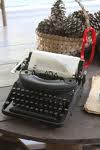Novel Spaces is in its 10th year! Over the coming weeks we'll be featuring some of the most popular posts from our archives. This one was first published July 28, 2010.
By Carol Ottley-Mitchell

Let me share a little secret with you. I am very old fashioned when it comes to writing.
We have to keep this to ourselves because in my other life, I work with computers; I write computer software, consult on information management and create websites. When it is time to create literature, however, I find it impossible to do so at the computer, I must put pen to paper. I suspect that seeing the words on paper, the way that my readers would, provides some level of inspiration. I probably would have done very well with a manual typewriter.
This stumbling block makes writing a very laborious process since, having written the words, I must then transcribe my scrawls into an electronic form so that they can easily be edited and shared. Being a techie, I have done some research in an attempt to make this process a little less painful.
Intelligent character recognition software is one possible solution to my problem. I could scan my jottings and use optical character recognition software to electronically translate my written words into characters that can be edited with a word processing document. The problem is that no software has yet been created that can decipher my handwriting. Years of computer use have caused my writing to deteriorate significantly. The legibility of my writing is often exacerbated by the fact that I often write in the car on long commutes on bumpy roads and sometimes I scrawl a paragraph or two in the dark on the pad that I keep next to my bed.
At one point I dabbled with electronic writing tools, a pen stylus to be exact. I connected it to my computer and wrote on a Tablet. This was several years ago, and the technology may have improved considerably by now, however, I was extremely frustrated with this method. The main problem was that the software reading the handwriting relied on me to make each letter basically the same way each time I wrote it. You see the problem. When I am on a writing roll, my thoughts are often flowing faster than I can write and the last thing that I need to worry about is forming my letters.
One more option that I have considered is speech or voice recognition software, which would require me to read my work aloud into a microphone and then have my words translated into electronic text. This would work well for me, because as a writer of children's books, I find it very useful to hear the words as they would be read by a caregiver. I have not yet made the step to purchasing and testing the software, however.
I am very interested in hearing if I am in a minority in terms of writing on paper and also, how others are using technology to enhance the creative writing experience.

No comments:
Post a Comment